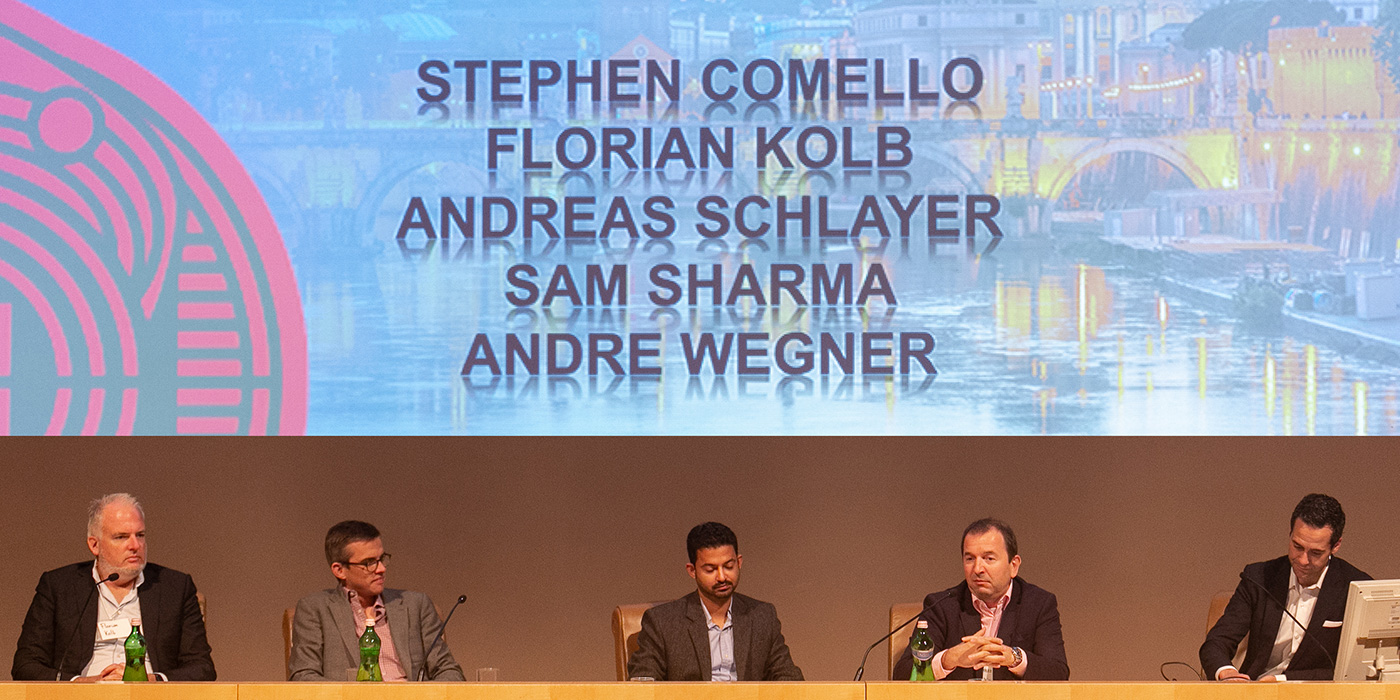On October 29th 2018, Intertrust and our partner LINE jointly held our 4th security summit entitled “Preparing for the Data-Driven Future” in Rome, Italy. The event was jam-packed with content from a number of notable speakers, and this will be the first in a series of blog posts on the event. One of the highlights of the day was a panel discussion entitled “The Clash of Titans: A Discussion of Cross-Industry Data-Driven Disruption.” With all of the buzz around data-driven business models, the panel provided unique and much needed insight as to where companies actually are in transforming themselves with data and the challenges they have in reaching the oft-promised future.
As the title suggests, the panel brought together representatives from several industries and companies representing different geographies and stages, from Silicon Valley startups to a large European utility with 120 years of operating history. Speakers were Andre Wegner, CEO of Authentise, a startup working on an industrial 3D printing platform, Florian Kolb, Managing Director at innogy New Ventures, the corporate venture capital arm of the European utility innogy, Andreas Schlayer, Senior Underwriter Cyber Risks at the storied reinsurance company Munich RE, and Sam Sharma, Head of Growth & Corporate Finance, Uber Eats. The panel was moderated by Stephen Comello, Director of the Sustainable Energy Initiative, Stanford Graduate School of Business.
Data and “Virtual Kitchens”
One of the interesting themes that came out from the discussion was the differences between Uber Eats, an Internet native company that generally controls its own data versus the other companies that have more complicated situations around rights to data. Sam Sharma noted that Uber Eats was essentially a “food delivery platform built on top of Uber’s big data platform.” Uber Eats uses Uber’s vast pool of data to understand consumer consumption patterns as well as to figure out how to use the data to reduce the cost of food delivery.
According to Sharma, Uber Eats also uses this data to work with restaurants to create “virtual kitchens.” These are restaurants that use excess capacity to cook food for delivery that may not normally be on their menu. As an example, Uber’s data shows that there is a demand for hamburgers in Rome, “but it’s a demand that’s not being met,” (Sharma). Seeing this demand, Uber Eats would then work with restaurants to cook and deliver hamburgers, helps the restaurants to increase sales. Sharma also said that Uber’s data platform gives them the flexibility to do “thousands of experiments” to come up with the right products.
Complicated Data Relationships
Uber Eats’ experience is vastly different than Munich RE’s. While insurance is an entire industry built on data, it generally isn’t the insurance company’s data. Andreas Schlayer said that insurance companies have to ask others for data and “the person who gives it to you ties regulations to it.” Since there are large penalties if the data is somehow lost, insurance companies really can’t create data lakes but something more like “15,000 swimming pools,” (Schlayer). He also said the capex of managing and working with this data is enormous.
As a 3D platform company, Authentise is an Internet native company but it also has the same problem that Munich RE has, that the data they work with to print out parts typically isn’t theirs. Andre Wegner said that to get the rights to use some of the data associated with their customers, “we have to deal with hordes of lawyers,” so typically they don’t get those rights. To help their company get around these issues, Wegner said they were looking to come up with ways that their customers would realize more value if they were to share their data with Authentise.
For innogy, creating new data-driven business models is an existential crisis since according to Florian Kolb. With the rise of renewable energy, the company sees the cost of energy dropping to zero. “The question is when it will start,” (Kolb). Kolb described the situation of data at energy companies as “a bit of a mixed bag.” One issue is it would seem utilities should have the rights to the data produced by their equipment but often the companies neglected to get the rights to their data in the contracts with the hardware OEMs. Grid data is under the control of energy companies and the same can be said generally of usage data from industrial and business customers. However, consumer smart meter data is a different matter. In privacy obsessed Germany, innogy has to ask its consumer customers to opt in to share data. Kolb noted that they need to come up with clear messaging about the value consumers get when they do so.
One area that all the panelists agreed on was that they all need better and more seamless ways of sharing data with partners. For Munich RE, Schlayer said that methods of exchanging data in a secure fashion were a key part of creating more complex but valuable products for the company. Even for Uber Eats, Sharma said, “How to share data while ensuring data privacy is a key focus area for us.”
About Phil Keys
Phil Keys is a Director, Comms & Research for Intertrust Technologies. He is a veteran technology industry observer, marketer, connector, and writer based in Silicon Valley. In addition to 13 years of experience as a Silicon Valley Correspondent for Nikkei Business Publications, Phil has worked for technology companies in both the US and Japan. Phil has spoken publicly in events in Tokyo and Silicon Valley as well as moderated panels in Silicon Valley. He holds a B.A. from the University of California at Berkeley and attended International Christian University in Tokyo.
